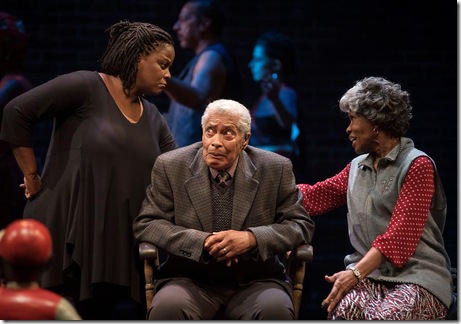Adventures of a Black Girl: a fascinating retelling of Black Canadian History that feeds off the multiple elements of oral performance.
Photo: NAC English Theatre.
This exciting coproduction of the NAC English Theatre/Centaur Theatre Company in association with the Montreal Black Theatre Workshop plunges us into a world where choreographed singing bodies take over the stage and fill the space with a retelling of Black Canadian history. Filtering the main moments into rituals of death fused with Judeo-Christian and African origin, playwright and director Djanet Sears has created an all-encompassing performance locating the characters squarely in Canada but she creates an exciting dialectic by correcting the ignorance the misconceptions, and the prejudices that tainted white perceptions of Black history in this country.
The author has interwoven a series of subplots that are staged with clarity and precision, keeping us aware of the different performance styles that underlie these different narratives that eventually work together to answer the burning question suggested in the title. The death of Rainey’s daughter has badly shaken her faith. Rainey, played by Lucinda Davis, tries desperately to understand how such a powerful being could actually allow such a tragedy to happen. The ongoing divorce with preacher husband Michael becomes another part of this difficult quest to understand this situation. The dialectic also includes a feisty team of five old time activists who lived through the troubling Sixties, and now want to end their lives by “liberating” the important symbols of their history, that have been buried, distorted or purposely forgotten. That must be their legacy. They are especially aiming at a town council decision to rename a place called Negro Creek, an area of land that belonged formerly to the Ojibway but was given to Black Veterans of the war of 1812. The seriousness of their demands and their military attack on the museum (among other places) is a joyful moment of old time comedy that had us all jumping in our seats with pleasure as veteran actor Walter Borden whips his little commando (two men and three women) into shape!
Central to these various theatrical situations is the exquisite performance of Walter Borden as the old Judge Johnson, father of Rainey, a gallant man about town (in his youth), smiting the ladies at every turn, and mostly, a survivor of the 1960,s movement lead by Martin Luther King Jr. Borden with his fiery personality, his resounding voice and sense of humour that trickles out of every inch of his body as this new inspirational version of Martin Luther King Jr with even more kick, definitely gives the whole chorus of dancers, and powerful a Capella singers a great run for their money. Such an actor has to be celebrated and I think that Djanet Sears had done this in no uncertain terms. The ultimate tribute to the actor and his character was given by a Jackie Richardson (also one of the fighting five!) Whose immense reputation as the best jazz singer in the country lit up the theatre and had the audience clapping during a most solemn moment of death, as pain and woeful grieving became strongly physical moments of vocal elation, especially in the church. Here, the music of composers Djanet Sears and Alejandra Nuñez was completely uplifting. Clearly, religion of all expressions was ever present at this event, in spite of Rainey’s refusal to believe, as the singing, the music and the corporeal performances took hold at every moment. Thus we can say that this was an exquisite example of ensemble acting where the the group took over the stage and no individual really stood out, except Borden who has the history we recognize, and Robinson who tore the NAC theatre apart with her interpretation of “Big Mama Thornton” several years ago.
Also impressive was the way Vivine Scarlett choreographed the chorus, transforming the set into living parts that move across the stage and settle themselves into the right spaces. This crowd of dancers and singers also morphed itself into portions of the set, including the liquid element of Negro Creek where bodies have often been discovered . Ultimately, the chorus incarnated the ritual events that flowed over the stage and brought us close to another world where bodies and voices meet in the magic space of orality.
Such a powerful show. Perhaps the last fifteen minutes were not necessary because they do repeat what was already expressed. No need for that. All was already perfect..
The Adventures of a Black Girl in Search of God plays in the theatre of the NAC until November 7. 2015.
Written and directed by Djanet Sears, music composed by Alejandra Nunez,
